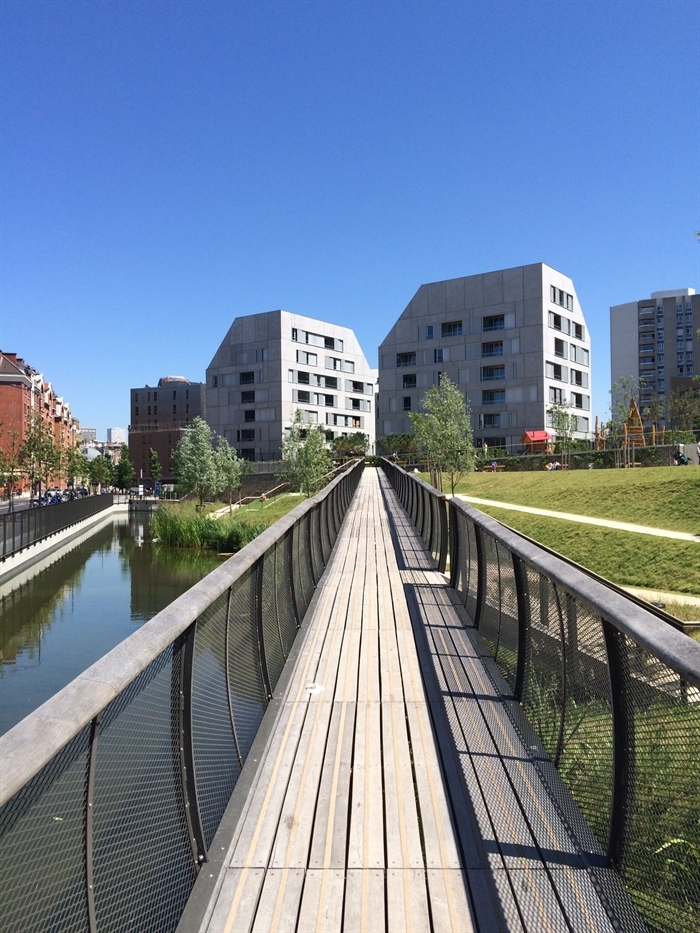
Yonah Freemark
The Gare de Rungis ecodistrict saves Paris money by absorbing most of the area's stormwater on site.
One thing is immediately apparent to any visitor to Paris: It is a very dense city, with more than four times as many people per square mile as Chicago.
All that density creates a very vibrant atmosphere, with cafes and shops everywhere and people crowding the streets. But it also produces significant stress on the city’s infrastructure, in part because of the population’s need for potable water and also due to a relative lack of permeable surfaces. Like in many cities, during heavy rains Paris’ sewers have to absorb the large majority of stormwater. This, in turn, requires high-capacity outflow pipes and significant energy use for treatment since Paris, like Chicago, has a combined sewer system.
Though some of these needs have been addressed through a very extensive regional stormwater system, including a recently opened reservoir-tunnel under the south side of the city and a new French law that requires either green roofs or solar panels on top of new commercial buildings, Paris still suffers from occasional sewer overflows into the Seine River in cases of dramatic rainfall.
One way to address these problems is to build more infrastructure, but that is costly and requires expensive maintenance over time. On the south side of Paris, a different approach is being piloted in the Gare de Rungis ecodistrict, which I visited this month. There, a new community has been constructed specifically to avoid stressing the city’s water supply and stormwater systems, and it is an excellent model for new developments in the U.S.

Yonah Freemark
This 9.4-acre mixed-use neighborhood was completed in May 2015 (the first building opened in 2012) and is the city’s first ecodistrict, with all buildings meeting European low-energy use requirements similar to the U.S.’s LEED certification. The district was built on the site of a former freight train station on the edge of the city and undertaken by the public developer SEMAPA, which is mostly controlled by the City of Paris. It is directly adjacent to the city’s T3 light rail line and in the heart of an existing neighborhood. Its development was coordinated by architect Bruno Fortier.
The neighborhood’s program includes a 54,000-square-foot park, a neighborhood social center, community gardens, an 80-seat day care center, a 100-bed retirement home, 75 market-rate housing units, 183 university housing units for students and researchers, 205,000 square feet of offices and retail space, including a street-facing cafe. Parking is limited, with just 87 spaces for the expected 950 workers and priority in the district for pedestrians and cyclists.
Most of the buildings include solar panels to cover a portion of electricity needs, and all buildings include solar water heaters, which cover about half of the hot water needs in most of the buildings.
But most impressive is the way the neighborhood was constructed to avoid stressing the water supply and stormwater systems. Each of the buildings is designed to collect stormwater, which is then stored in tanks that can hold up to 48,000 gallons in total. This water is reused for private gardens in and around each of the buildings, as well as toilets in the offices and student housing. This reuse reduces the need for new, potable water from elsewhere.
Below the development is a 120,000-gallon tank designed to store general runoff from streets, and the park includes a pond that can store up to 79,000 gallons of water. The pond’s water level rises and falls depending on the weather, and the tanks inject water into the ground over time. These investments allow the project to reduce by up to 50 percent its users’ contribution to the city’s stormwater system. If and when the pond and tanks are full, any overflow into the city’s system is distributed slowly.
Paris is not the first city to invest in an ecodistrict like Gare de Rungis, but its implementation at the center of a dense city suggests that even at a relatively small scale it is possible to significantly reduce a development’s water supply needs and its contribution to the stormwater system at the heart of a major urban region.